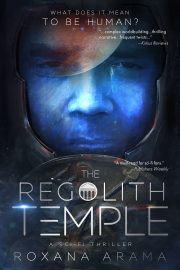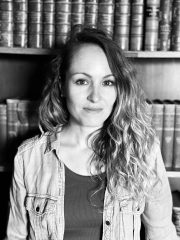Tackling the Dreaded Bio
by Luna Lindsey
 A lot of authors hate writing “bios.” We can crank out a 100,000 word novel no problem, but a 100 word bio for the back cover? Terrifying.
A lot of authors hate writing “bios.” We can crank out a 100,000 word novel no problem, but a 100 word bio for the back cover? Terrifying.
I once hated bios too, but now they’re just another ten minute overhead part of my day, a happy task since it means I’ve sold a story. With just a little bit of work, it can be this easy for you.
How did it get so easy? Read on!
What a Bio Accomplishes
Bios seem like such a chore, perhaps because we think of them as an obnoxious necessity rather than an opportunity. As writers, we also tend to dislike telling our own stories. And that’s exactly what a bio does.
When a reader bothers to check the bio, it’s because your story (or blog post, or appearance on a panel) has captured their interest. They want to know more and that’s awesome! A catchy bio will help them remember you, and they may even be inspired to seek out your other creations. That’s exactly what you want. Your bio will propel them into your other worlds. So make it good!
(But no pressure or anything.)

Same bat-author, different bat bios!
Each of my bios contains a hook (just like the first line of a story: make them want to know more), a couple of relevant publication credits or achievements, and references to my blog and twitter so people can find me.
And I try to customize each bio to include an element that matches the story I’ve written or venue I’ll be speaking to. My bio for a presentation on religious recovery will be quite different than my Norwescon profile as a sci-fi author.
First Bio Session
Bios are just like any other kind of writing; they get easier as you practice. You only need to do this part once, to help you grok the structures and patterns for biographical sentences, to make them part of you, just like the skill of writing captivating character descriptions. If you do a little front-loading ahead of time, you can streamline the process for later.
Set aside a couple of hours and spend them drafting lots of little bios and partial bios. During this time, go to an online bookstore and study professional bios from a handful of favorite authors. See which voices and tones you like. What grabs your attention? What makes you want to know this author better? Do you like funny or serious bios? Interesting backstories? Bios that make the author seem mysterious or enchanting?
Think about the tidbits you found interesting in these writers’ lives. You may think you have nothing this fascinating in your backstory, but you do! Let your mind wander. Remember, these are just drafts, not your final product. Think of it as brainstorming, a discovery writing exercise to develop your character.
Many hobbies, histories, and habits that seem mundane in your life are probably interesting to someone else, especially when compressed into a single sentence. Turn brevity to your advantage. You can’t tell your whole life story in 100 words, so hitting the key points, without explanation, transforms your supposed banality into intrigue.
What odd topics have you studied? Has anything strange ever happened to you? What do you value most in the world? Do you want to present as funny, caring, family-oriented, or smart? Choose the tidbits that reflect the image you wish to present. Then take a few stabs at cramming these fun facts into sentences. It’s exactly like character description, only it’s you!
Through this process, you will discover your bio voice, which will be easier to snap back into later.
Assemble your favorite lines into a short paragraph and let it sit for a few days. Come back and revise.
You now have a basic go-to bio that you can use anywhere, the foundation which you’ll adjust to craft unique bios when called upon.
Organize
Give an important gift to your future self:
Take your basic bio and put it in a safe place. I use Scrivener to organize my notes, where I keep a folder to store each bio, categorized by subject, with a reminder about who I wrote it for, plus stray bio-darlings that didn’t fit in the generic bio.
Organization: The gift that keeps on giving.
I also keep factual tidbits here: My publication credits, links to my work, and items that interviewers often ask for (like a list of hobbies, favorite authors, etc.)
Everything I need is in one place, with no time-consuming obstacles to frustrate smooth production of my next bio request.
Customize
So the editor wants a bio, and she needs it by this afternoon. No stress! A fresh, custom bio is just minutes away.
Head to your bio storage facility. Over time, you will build up a collection of pre-written bios from the past, so pick the most recent, relevant one. For instance, if I need it for a sci-fi con, I pick last year’s con.
Then check the bio for facts that need updating. Got a new publication credit or have additional word count? Get to it!
For stories, I try to include a little about my background that relates to the piece. I may need to toss out my standard lines to make room.
For instance, the protagonist in Touch of Tides is a synesthete, so I added a line about my own synesthesia. If the reader is curious enough to read the bio, this fact will reinforce the theme or topic of the story, which will help them remember me. It also adds credibility to the story itself; the reader realizes I have direct experience and I’m not just making things up. Well, I am making things up, but the illusion is magnified. And so is their interest in my other work.
Finalize!
Publish, rinse, repeat, and the easier it gets. Before long, the more stories you sell and appearances you make, bios will become as easy as telling tall tales. And almost as fun.
•••
Luna Lindsey lives in Seattle, WA. Her first story (about a hippopotamus) crawled out of her head at age 4. After running out of things to say about hippopotami, she switched to sci-fi, fantasy, and horror. Her stories have appeared in the Journal of Unlikely Entomology, Penumbra eMag, and Crossed Genres. She tweets like a bird @lunalindsey and blogs at www.lunalindsey.com. Her novel, Emerald City Dreamer, is about faeries in Seattle and the women who hunt them.



